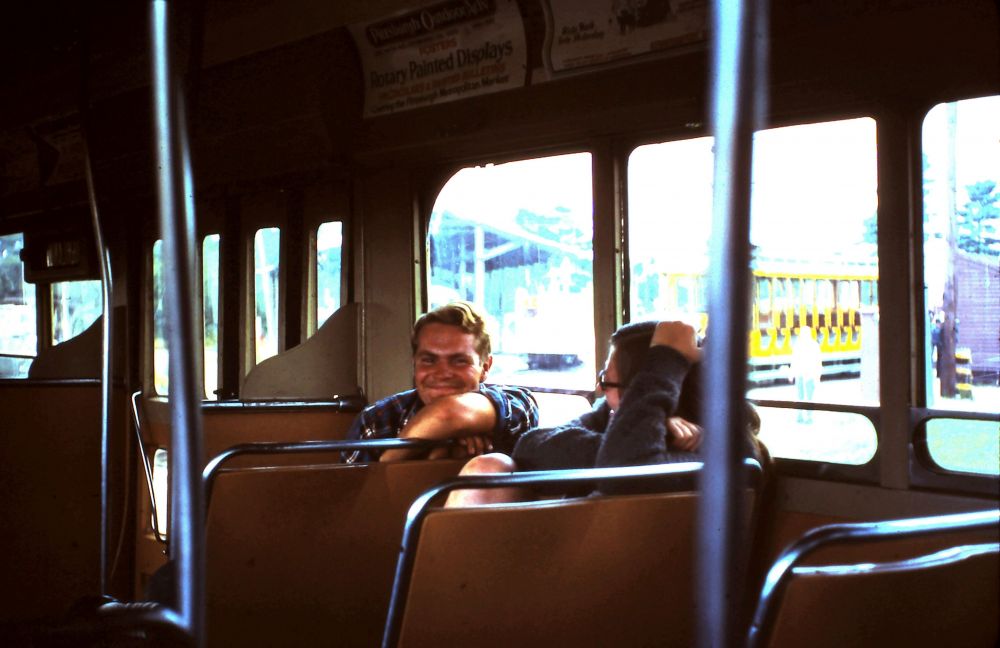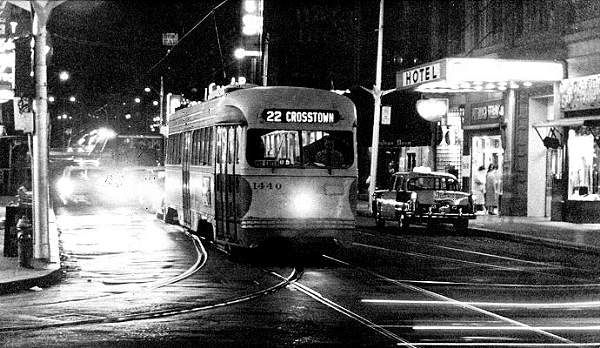
- Builder
- St. Louis Car Co.
- Description
- PCC, Wartime air-electric
- Secondary Use
- None
- Type
- City and Suburban Streetcars
- Year
- 1942
- Retired from Service
- 1968
- Acquired by the Museum
- 1968
- Note
- As of April 2017, No. 1440 was in Central carbarn. The car has a chipped tire and has evidence of corrosion damage to the body bolsters.
- Fund
- 813
Pittsburgh Railways 1440
From Pittsburgh, Pennsylvania
History
The PCC car takes its name from the Electric Railway Presidents Conference Committee established in the early 1930s to design a modern, streamlined streetcar. It was a successful design with approximately 5000 PCC cars being built between 1936 and 1952 for systems in the U.S. and Canada. Some PCC cars built after World War II used the all-electric variation having electric brakes instead of the earlier air-operated brakes. The city of Pittsburgh, home to the Westinghouse Electric and Air Brake companies, was an enthusiastic PCC operator, taking delivery of the very first production car in 1936, and 665 more over the next 13 years. Pittsburgh was one of the few major cities, along with others such as Washington, Boston, Toronto and San Francisco, to completely modernize its system with PCCs prior to major contraction of the streetcar systems. The 1942 order of 100 cars, numbered in the 1400 series, used a distinctive 24 degree windshield slope, later used extensively in Boston, but not on subsequent Pittsburgh orders. The privately-owned Pittsburgh Railways operated most of its system with streetcars into the 1960s, long after other cities had converted to buses and public ownership. Pittsburgh Railways completely rehabilitated No. 1440 in 1962. In 1964, the Port Authority of Allegheny County (operating under the name Port Authority Transit) took over Pittsburgh Railways and began converting most lines to buses. PAT removed the 1400 series cars from service in 1967 when it converted the East Side lines to bus.
n 1968, No. 1440 was the first PCC to come to Seashore. The Pennsylvania Railway Museum Association (now, Pennsylvania Trolley Museum) at Washington, PA assisted Seashore in selecting the car, negotiating with PAT and loading the car for transport. Seashore quickly replaced the roof and repainted the interior and exterior. The exterior carries the Pittsburgh Railways crimson and cream paint scheme. Like other Pennsylvania streetcar systems, Pittsburgh used a 5’ 2 ½” track gauge. So, Seashore replaced the wheel and axle assemblies in No. 1440’s wide gauge Clark B-2 trucks with standard gauge wheel and axle sets acquired from Boston’s MBTA but originally from Washington’s DC Transit. Seashore also modified the tread brakes and track brakes to standard gauge. The MBTA initially turned down Seashore’s request for the wheel and axle sets as they still operated a large PCC fleet and retained the DC trucks as spares. However, when the MBTA had an urgent need for an overhead wire line car, Seashore responded by lending ex-Claremont, NH car No. 4 in return for the four Washington wheel and axle sets. No. 1440 was in operation at Seashore at various times. Unfortunately, the paint used to refinish the car inside and out (and which was the exact paint used in Pittsburgh) did not hold up well and has deteriorated. This poor paint performance helped explain why, in later years, Pittsburgh’s PCCs, though in good mechanical condition, often looked shabby.
Technical Information
- Seats: 54
- Control: Westinghouse PCC
- Brakes: Dynamic / Air Tr / Track
- Compressor: PC-2
Trucks
- Number: 2
- Manufacturer: Clark
- Model: B-2
Motor
- Number: 4
- Manufacturer: Westinghouse
- Model: 1432
Weight and Dimensions
- Length: 46’
- Width: 8’ 4.00"
- Height: 11’
- Weight: 36080 lbs.
Additional Images

Paul Kehoe in May 1971

Paul Kehoe in Sept 1970

On Sixth Ave. in Pittsburgh - John Froyd Collection at newdavesrailpix.com
© 1998 - 2025 New England Electric Railway Historical Society. All Rights Reserved.